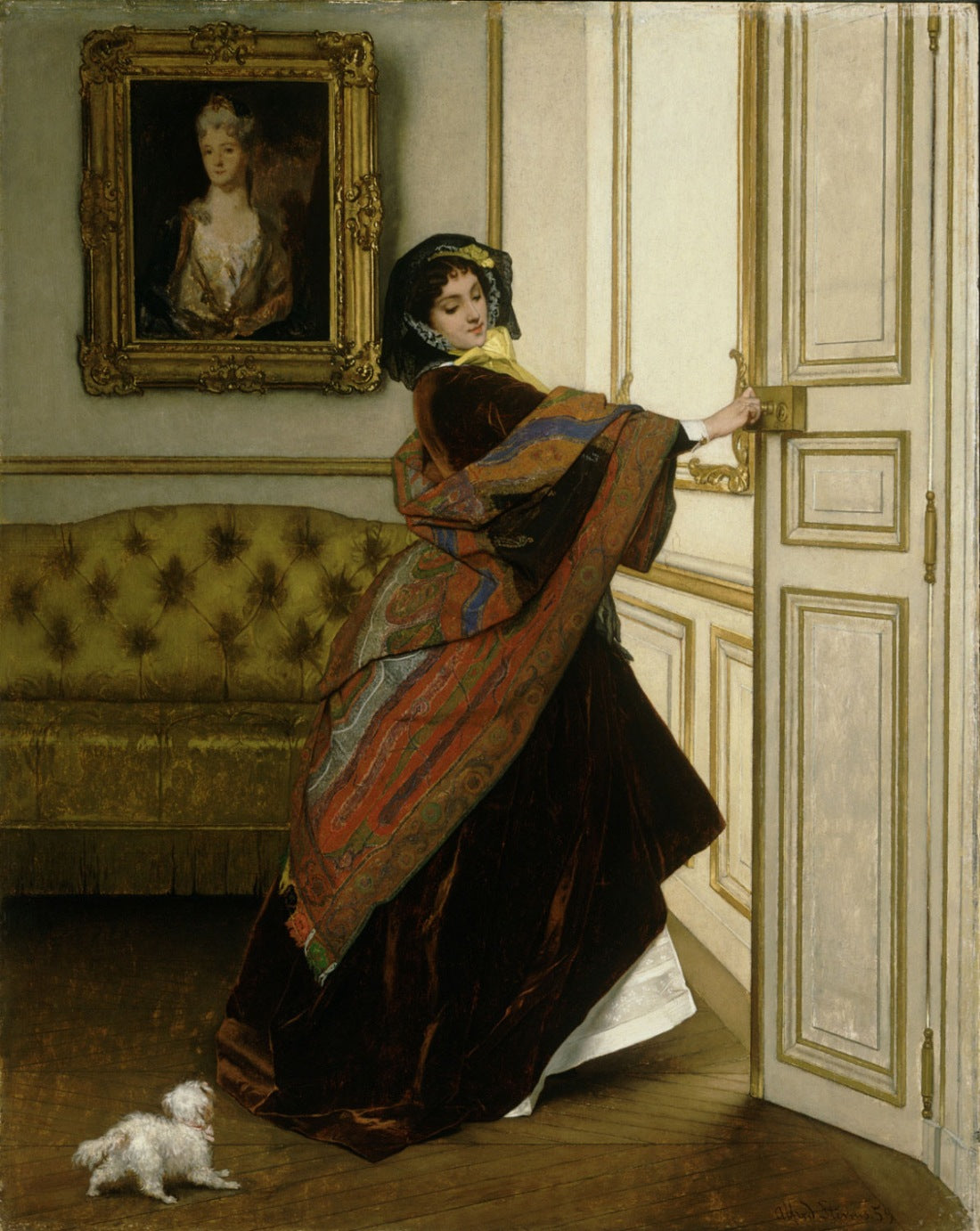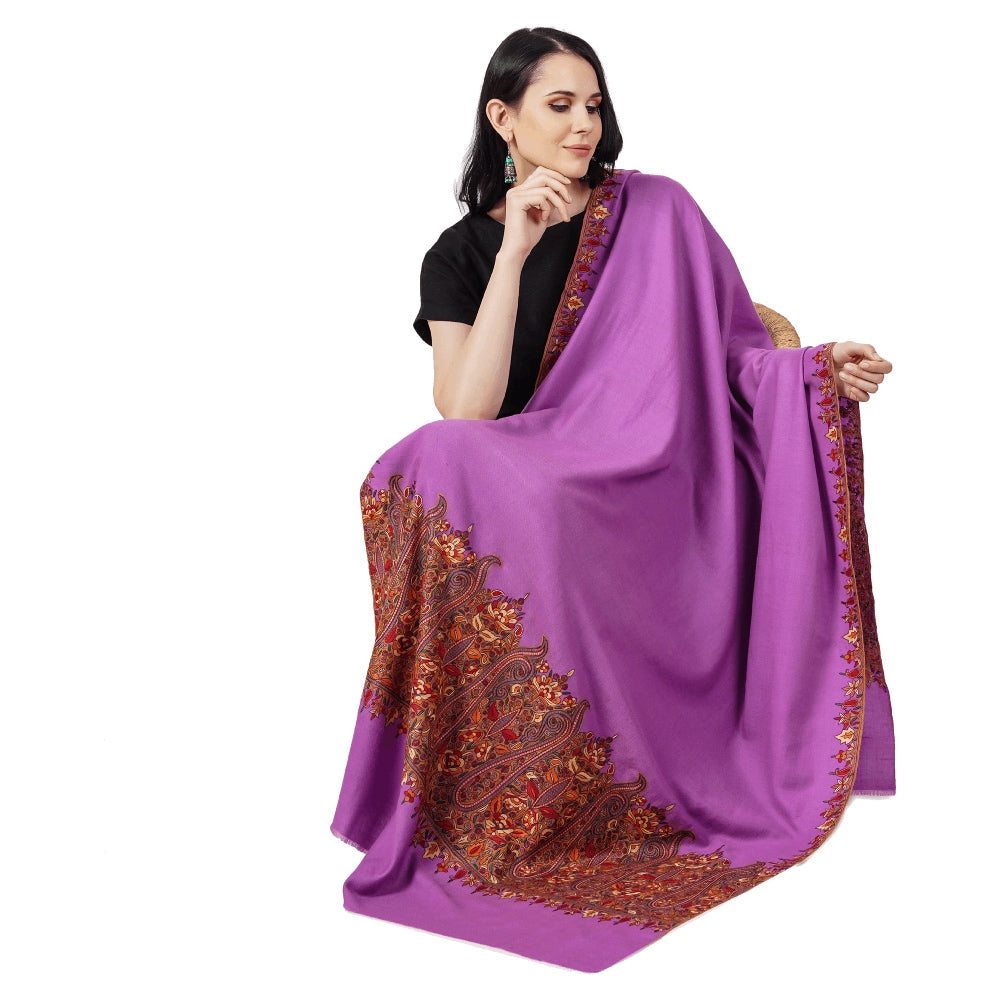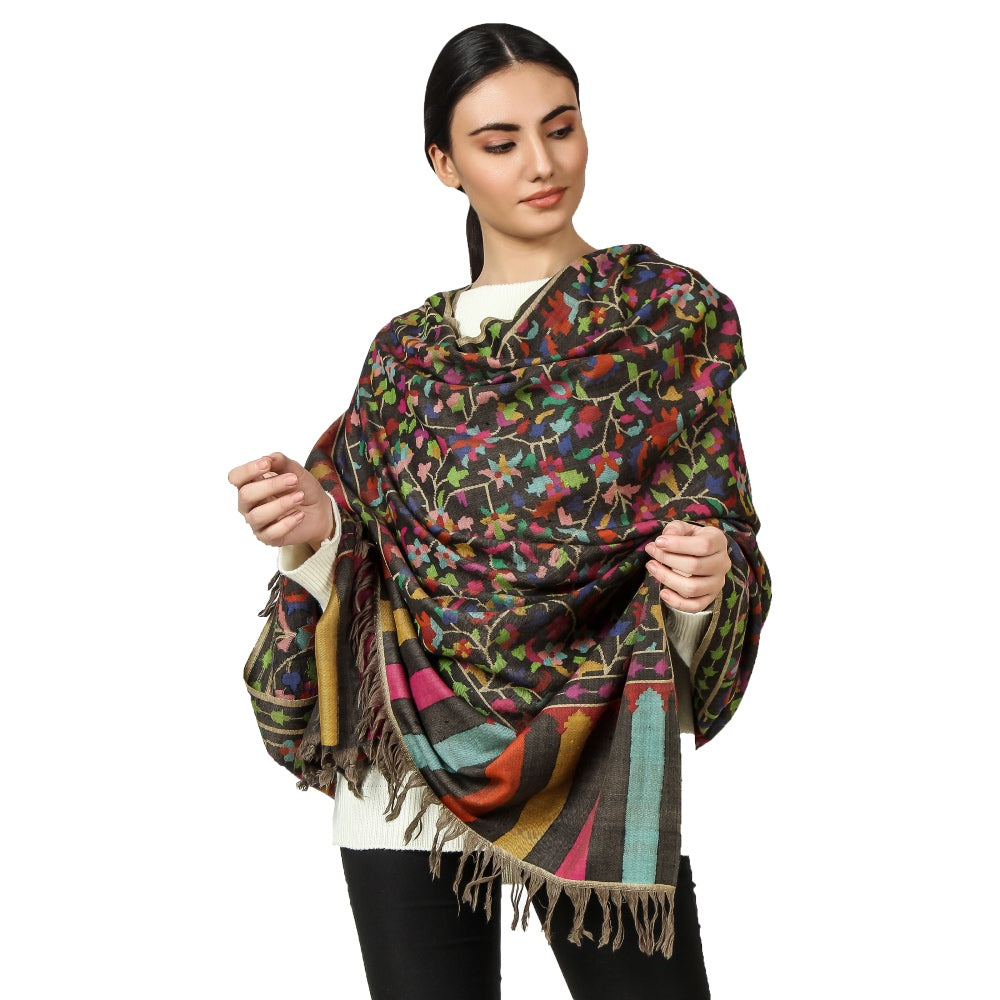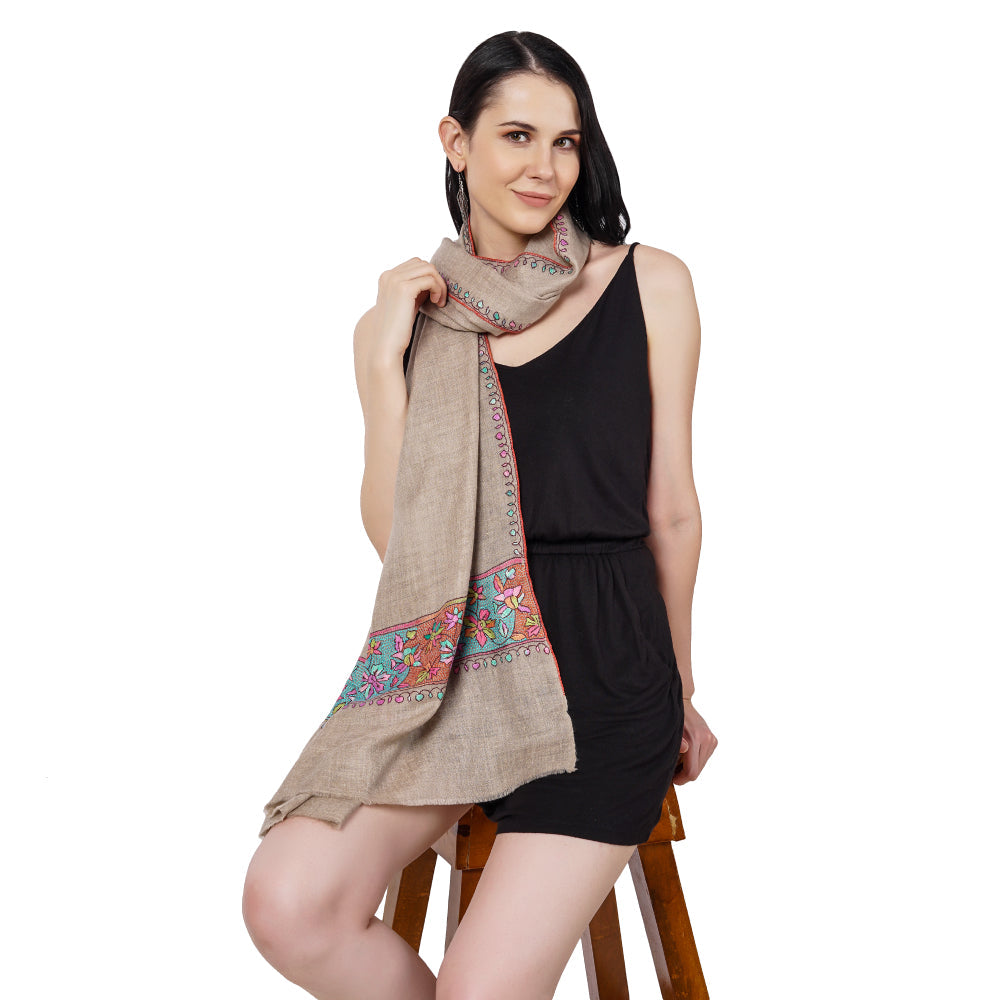
The Legends of a Kashmiri Shawl: A Rich Cultural Heritage
Share
A Kashmiri shawl is a type of woven or embroidered woolen garment made in the Indian region of Kashmir. It is typically made of pashmina wool, which is sourced from the high-altitude regions of the Himalayas. Kashmiri shawls are known for their fine quality, intricate designs, and exquisite embroidery, which have made them highly valued luxury items across the world. The term "shawl" is a Persian word meaning a piece of cloth that is wrapped around the body. A Kashmiri shawl is typically rectangular in shape and can be worn in a variety of ways to provide warmth and elegance to the wearer.
Brief history of Kashmiri Shawls

Kashmiri shawls have a long and rich history that dates back to the 3rd century BC. They were first produced by the weavers of Kashmir as a way to protect themselves from the harsh cold weather of the region. In the 14th century, the Mughal emperor Akbar the Great was so impressed with the quality of Kashmiri shawls that he decided to bring Kashmiri weavers to his court in Delhi. This led to an increase in demand for Kashmiri shawls, and soon they became a symbol of luxury and wealth. Over the years, Kashmiri shawls have evolved, with various weaving techniques and embroidery styles being introduced. Today, they are widely considered to be one of the most valuable and prestigious types of shawls in the world.
Also read: A Journey through time: The history of Pashmina Shawls
Importance of Kashmiri shawls in culture and fashion

Kashmiri shawls have been an important part of Indian and Kashmiri culture for centuries. They have been used in traditional ceremonies, weddings, and festivals. Kashmiri shawls have also been popular among the royal families of India and other parts of the world, who have appreciated their beauty and quality. In terms of fashion, Kashmiri shawls have been embraced by designers worldwide, who have incorporated them into their collections. They have been adapted to suit modern tastes, with contemporary designs and color schemes being introduced. Kashmiri shawls have become a timeless and versatile accessory, that can add an element of elegance and sophistication to any outfit. They are considered a must-have accessory in many fashion circles and are highly prized by collectors and enthusiasts.
Origin of Kashmiri Shawls

Kashmiri shawls have a long and rich history that dates back to the 3rd century BC. They were first produced by the weavers of Kashmir as a way to protect themselves from the harsh cold weather of the region. Over time, the production of Kashmiri shawls evolved into an art form, with weavers and embroiderers creating intricate designs and patterns that were highly valued by royalty and the elite. The influence of Mughal and Persian cultures on the design and embroidery techniques of Kashmiri shawls can be seen in the intricate floral and paisley motifs, as well as the use of rich colors and gold thread. The use of fine materials such as pashmina and shahtoosh wool further contributed to the high value and prestige of Kashmiri shawls. Today, Kashmiri shawls continue to be a symbol of luxury and sophistication, with their fine quality and intricate designs being highly prized by collectors and enthusiasts.
Geographical and climatic conditions of Kashmir

The region of Kashmir is situated in the northwestern part of the Indian subcontinent, bordering Pakistan and China. It is a mountainous region with a unique geography and climate. The region's high-altitude plains, deep valleys, and cold weather make it an ideal location for producing high-quality wool. Pashmina wool, which is used to make Kashmiri shawls, comes from the undercoat of the Changthangi goat, which is found in the high-altitude regions of the Himalayas. The harsh climatic conditions of Kashmir have contributed to the development of wool that is finer and more luxurious than any other wool found in the world.
Influence of Mughal and Persian culture

The production of Kashmiri shawls was greatly influenced by the Mughal and Persian cultures that flourished in the region during the 14th and 15th centuries. The Mughals, who were great patrons of the arts, encouraged the production of high-quality textiles, including Kashmiri shawls. The Persian influence on the design and embroidery techniques of Kashmiri shawls can be seen in the intricate floral and paisley motifs, as well as the use of rich colors and gold thread. The influence of Mughal and Persian culture on Kashmiri shawls is still evident in the designs and patterns used by weavers and embroiderers today.
Evolution of Kashmiri shawls from pashmina to Shahtoosh

The evolution of Kashmiri shawls from pashmina to shahtoosh is a testament to the skill and ingenuity of Kashmiri weavers. Pashmina wool, which is sourced from the Changthangi goat, was the primary material used to make Kashmiri shawls for centuries. However, in the 19th century, weavers began experimenting with a new type of wool known as shahtoosh. Shahtoosh is an ultra-fine wool that comes from the Tibetan antelope, which is found in the high-altitude regions of the Himalayas. Shahtoosh shawls are even finer and more delicate than pashmina shawls, and are considered the ultimate luxury item. However, due to the endangered status of the Tibetan antelope, the production of shahtoosh shawls has been banned, and pashmina shawls have once again become the primary material used to make Kashmiri shawls. Today, Kashmiri shawls continue to be made using traditional techniques and materials, ensuring that the art of Kashmiri shawl-making is preserved for generations to come.
Also Read: What is so special about Pashmina Shawl?
The Making of Pashmina Shawl

The making of a Kashmiri shawl is a complex and intricate process that requires great skill and attention to detail. It begins with the sourcing and processing of high-quality pashmina wool, which is then sorted and graded according to its fineness and quality. The wool is then spun by hand and woven on traditional handlooms using either the Kani or Taafta loom. The shawl may then be embellished with intricate embroidery using a variety of techniques, including aari embroidery, tilla embroidery, and sozni embroidery. The use of decorative elements such as beads and sequins further adds to the richness and complexity of the design. The entire process is done by hand and can take several months or even years to complete, resulting in a unique and highly valuable work of art. The making of a Kashmiri shawl is a testament to the skill and craftsmanship of the weavers and embroiderers of Kashmir, who have perfected this art form over centuries.
Sourcing and processing of pashmina wool

The making of a Kashmiri shawl begins with the sourcing and processing of high-quality pashmina wool. Pashmina wool comes from the undercoat of the Changthangi goat, which is found in the high-altitude regions of the Himalayas. The wool is collected during the spring molting season, when the goats naturally shed their undercoat. The wool is then washed and spun by hand, a labor-intensive process that requires great skill and attention to detail. The resulting yarn is then sorted and graded according to its fineness and quality.
Also read: The most expensive wool in the world.
Types of looms used in weaving Kashmiri shawls
The weaving of Kashmiri shawls is done on traditional handlooms, which come in two types: the Kani loom and the Taafta loom. The Kani loom is a small, portable loom that is used to create intricate designs and patterns in the shawl. The Taafta loom, on the other hand, is a larger loom that is used to create the body of the shawl. Both looms are operated by hand and require great skill and dexterity to operate.
Techniques used in embroidery and embellishment
The embroidery and embellishment of Kashmiri shawls is done by hand, using a variety of techniques and materials. The most common technique is called aari embroidery, which involves the use of a hook-like needle to create intricate designs and patterns on the surface of the shawl. Other techniques include tilla embroidery, which uses gold or silver thread to create elaborate designs, and sozni embroidery, which involves the use of silk thread to create delicate floral motifs. The shawl may also be embellished with beads, sequins, and other decorative elements to add texture and sparkle to the design. The embroidery and embellishment of Kashmiri shawls is a highly skilled and time-consuming process, with some shawls taking months or even years to complete.
Legends and Stories of Kashmiri Shawls
Kashmiri shawls are steeped in legends and stories that have been passed down through the generations. One of the most famous legends is that of the Jamawar shawls, which are known for their intricate patterns and designs.
Another famous story is that of the Kani shawl weavers, who were said to have been gifted with supernatural powers. Legend has it that the weavers could see the designs in their minds and weave them into the fabric without the use of a pattern. The Kani shawl weavers were highly respected and were often sought after by royalty and the elite.
Finally, there is the tale of the Shahtoosh shawls, which were made from the wool of the Tibetan antelope and were said to be so fine that they could be passed through a wedding ring. These shawls were highly prized by royalty and were often given as gifts to visiting dignitaries. However, the production of Shahtoosh shawls was banned due to concerns over the endangerment of the Tibetan antelope, making these shawls highly rare and valuable.
The legend of Jamawar shawls and their intricate patterns

The Jamawar shawl is one of the most famous and recognizable types of Kashmiri shawl, known for its intricate patterns and designs. According to legend, the patterns on the shawl were created by weaving together strands of moonlight, and were so delicate that they could only be seen in the light of the full moon. The shawls were traditionally made using the Handloom.
The Jamawar shawl is typically made from pashmina wool, which is a fine and delicate wool that is sourced from the high-altitude regions of Ladakh and Tibet. The wool is then processed and spun by hand, before being woven into a Shawl cloth which is them embroidered with sozni embroidery technique with the intricate patterns that are characteristic of the Jamawar shawl.
Today, Jamawar shawls are highly prized for their beauty and craftsmanship, and are often considered to be a symbol of status and luxury. The intricate designs and patterns are a testament to the skill and expertise of the weavers of Kashmir, who have been able to perfect this art form over centuries of tradition and practice. The legend of the Jamawar shawl and its association with moonlight only adds to the mystique and allure of these exquisite works of art.
The story of the legendary Kani shawl weavers

The Kani shawl is one of the most famous and valuable types of Kashmiri shawl, known for its intricate designs and use of vibrant colors. The production of Kani shawls is an art form that has been passed down through generations, and is often considered to be one of the most difficult and complex forms of weaving.
According to legend, the Kani shawl weavers were gifted with supernatural powers that allowed them to see the intricate designs and patterns in their minds, and weave them into the fabric without the use of a pattern. This skill made the Kani shawl weavers highly respected and sought after by royalty and the elite, and many of them were able to achieve great wealth and fame as a result.
Today, the Kani shawl is still considered to be one of the most valuable and sought-after types of Kashmiri shawl, and is often considered to be a symbol of luxury and status. The use of the Kani loom, which is a specialized type of loom that allows the weaver to create highly intricate patterns by working from a special code called Taliim, is one of the key elements that sets the Kani shawl apart from other types of Kashmiri shawls.
The story of the legendary Kani shawl weavers is a testament to the skill and craftsmanship of the weavers of Kashmir, who have been able to create these exquisite works of art through centuries of tradition and expertise. The Kani shawl weavers, with their supernatural ability to weave intricate designs, are part of the rich cultural heritage of Kashmir, and their legacy continues to be celebrated and revered today.
The tale of the Shahtoosh shawls and their royal connections

Shahtoosh shawls are known for their extreme softness and warmth, and are made from the fine hair of the Tibetan antelope. These shawls were once considered to be the ultimate luxury item, and were highly prized by royalty and the wealthy elite.
Legend has it that Shahtoosh shawls were so valuable that they were only worn by royalty, and that they were considered to be worth their weight in gold. The shawls were often given as gifts between rulers and nobles, and were seen as a symbol of power and status.
The production of Shahtoosh shawls is an art form that requires great skill and expertise. The hair of the Tibetan antelope is so fine that it must be carefully collected by hand, and the weaving of the shawl requires a great deal of patience and attention to detail.
Today, the production and sale of Shahtoosh shawls is illegal, due to the threat of extinction of the Tibetan antelope. However, the legacy of these exquisite shawls lives on, and their royal connections continue to be celebrated in the art world.
The tale of the Shahtoosh shawls and their royal connections is a testament to the high value placed on luxury goods in ancient times, and the lengths that people were willing to go to in order to obtain them. The exquisite beauty and craftsmanship of these shawls is a testament to the skill and expertise of the weavers of Kashmir, who were able to create these works of art through centuries of tradition and practice.
Significance of Kashmiri Shawls
Kashmiri shawls have been associated with luxury and opulence for centuries. They have been worn by royalty, aristocrats and wealthy individuals, and were often considered a symbol of status and power. The intricate designs and use of fine materials such as pashmina, shahtoosh and silk made Kashmiri shawls highly coveted and prized possessions.
Due to the high value placed on these shawls, they often served as heirloom pieces and family treasures that were passed down through generations. Families would take great care to preserve and protect their Kashmiri shawls, often storing them in special cases and only taking them out on special occasions. These shawls became symbols of family heritage and tradition, and were often viewed as priceless works of art.
In recent years, there has been a growing concern for the preservation of Kashmiri shawls, and the importance of sustainability in their production. The demand for Kashmiri shawls, coupled with the increasing popularity of fast fashion, has led to concerns about overconsumption and the impact on the environment.
To address these concerns, there has been a renewed interest in traditional techniques and sustainable practices in the production of Kashmiri shawls. This includes using natural dyes, sourcing materials from ethical and sustainable sources, and promoting fair trade practices in the industry.
Preservation of Kashmiri shawls is also being addressed through initiatives aimed at educating the public about the cultural and historical significance of these shawls, and the importance of preserving them for future generations. This includes efforts to promote the use of Kashmiri shawls in modern fashion, and to support the livelihoods of local artisans and weavers who continue to practice traditional techniques.
Contemporary Use and Adaptation of Kashmiri Shawls
In recent years, there has been a growing trend in contemporary fashion towards incorporating traditional designs and materials, such as Kashmiri shawls, into modern styles. This fusion of traditional and modern designs has resulted in unique and innovative fashion creations that showcase the beauty and versatility of Kashmiri shawls.
One way that designers have incorporated Kashmiri shawls into contemporary fashion is by using them as statement pieces. Shawls with intricate designs and bold colors are often paired with simpler outfits, such as solid color dresses or suits, to add an element of elegance and luxury to the overall look. This pairing of traditional and modern elements creates a unique and eye-catching style that is both sophisticated and trendy.
Another way that Kashmiri shawls have been incorporated into contemporary fashion is by using them as accents in modern designs. For example, designers have used shawl fabrics as trim on jackets or dresses, or incorporated shawl designs into the embroidery of modern blouses or skirts. These creative uses of traditional materials add depth and richness to contemporary designs, and help to showcase the beauty of Kashmiri shawls in new and exciting ways.
In addition to their use in fashion, Kashmiri shawls serve as an important source of livelihood for artisans and weavers in the region. Many local families have been practicing the art of shawl weaving for generations, and rely on the industry for their livelihood. By supporting the production of Kashmiri shawls, the fashion industry is not only promoting cultural preservation, but also supporting the livelihoods of local communities.
Overall, the contemporary use of Kashmiri shawls in fashion is a testament to the timeless beauty and versatility of these traditional pieces. By incorporating them into modern designs and supporting sustainable production practices, the fashion industry is helping to preserve a rich cultural heritage while promoting innovation and creativity in fashion.
Conclusion
Kashmiri shawls are not just beautiful and luxurious garments, but also represent a rich cultural history and tradition that dates back centuries. They have been treasured by people from all over the world for their exquisite craftsmanship and intricate designs, making them an important symbol of Kashmiri heritage.
The art of Kashmiri shawl making is a delicate and intricate process that requires a great deal of skill and patience, and is often passed down from generation to generation. As such, it is crucial that we take steps to preserve this art form and support the artisans and weavers who practice it.
One way we can do this is by ensuring that we are purchasing authentic, ethically-sourced Kashmiri shawls from reputable sellers. We can also support the livelihoods of Kashmiri artisans by promoting sustainable production practices and paying fair prices for their work.
In order to fully appreciate the beauty and significance of Kashmiri shawls, it is important to take the time to learn about their history and the stories and legends associated with them. By doing so, we can gain a greater appreciation for the skill and artistry that goes into making these timeless pieces.
In conclusion, Kashmiri shawls are a true treasure and a testament to the ingenuity, artistry, and beauty of the Kashmiri people. By supporting their preservation and continued production, we can help ensure that this rich cultural heritage will continue to be cherished and celebrated for generations to come.




